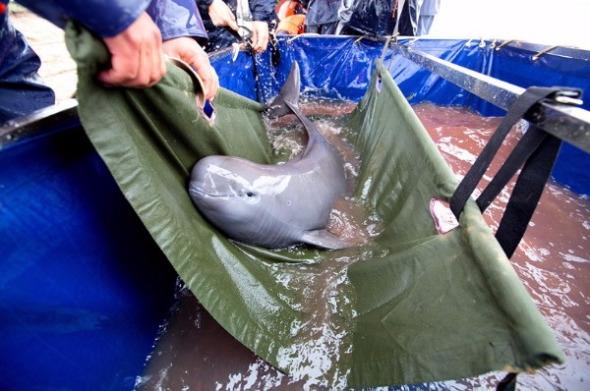
A finless porpoise is taken for a physical examination in Jiangxi province. The species has been classified as "critically endangered". (Photo provided to China Daily)
Recent research may provide good news about the endangered species.
The rate of decline in the number of finless porpoises in the Yangtze River may have slowed in the past six years, according to experts in the field.
Wang Ding, a researcher at the Chinese Academy of Sciences' Institute of Hydrobiology, said official statistics will not be released until March, but recent research may indicate positive steps in the conservation of the species, which is classified as "critically endangered" by the International Union for Conservation of Nature.
However, the river's environment is still deteriorating as a result of overexploitation of natural resources, while waterway regulations and water-related construction projects pose great threats to the porpoise's natural habitat, Wang said.
His comments came at the end of a scientific survey of the porpoise that was launched in Wuhan, Hubei province, on Nov 11.
The survey, conducted by CAS, reviewed the status of the species in the Yangtze River, its major tributaries and two lakes called Dongting and Poyang.
Financed by the World Wide Fund for Nature and charities in Hubei, the 40-day survey covered 3,400 kilometers of water, from Wuchang, Hubei, to Shanghai.
In 2006, a survey found that there were 1,800 finless porpoises in the wild. However, the number had fallen to 1,405 by 2012, indicating an annual rate of decline of 13.7 percent.
The number is now estimated to be less than 1,000, and the ministry placed the species under the highest level of State protection in May.
Freshwater species
The finless porpoise, a member of the toothed whale family, is so named because it lacks a true dorsal fin. Females produce a calf once every two years, and have a gestation period of 10 to 11 months. The species makes both high-and low-frequency tones and uses ultrasound to communicate.


















































